
The Pre-Raphaelite Brotherhood was a group of English painters, poets, and art critics, founded in 1848 by William Holman Hunt, John Everett Millais, Dante Gabriel Rossetti, William Michael Rossetti, James Collinson, Frederic George Stephens and Thomas Woolner who formed a seven-member "Brotherhood" partly modelled on the Nazarene movement. The Brotherhood was only ever a loose association and their principles were shared by other artists of the time, including Ford Madox Brown, Arthur Hughes and Marie Spartali Stillman. Later followers of the principles of the Brotherhood included Edward Burne-Jones, William Morris and John William Waterhouse.

Sir Edward Coley Burne-Jones, 1st Baronet, was an English painter and designer associated with the Pre-Raphaelite Brotherhood's style and subject matter.
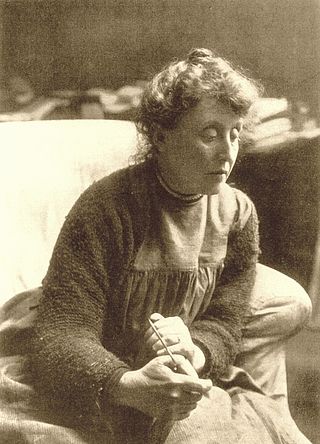
Evelyn De Morgan was an English painter associated early in her career with the later phase of the Pre-Raphaelite Movement, and working in a range of styles including Aestheticism and Symbolism. Her paintings are figural, foregrounding the female body through the use of spiritual, mythological, and allegorical themes. They rely on a range of metaphors to express what several scholars have identified as spiritualist and feminist content. Her later works also dealt with the themes of war from a pacifist perspective, engaging with conflicts such as the Second Boer War and World War I.

Jane Morris was an English embroiderer in the Arts and Crafts movement and an artists' model who embodied the Pre-Raphaelite ideal of beauty. She was a model and muse to her husband William Morris and to Dante Gabriel Rossetti. Her sister was the embroiderer and teacher Elizabeth Burden.

The Mystical Nativity is a painting in oil on canvas executed c. 1500–1501 by the Italian Renaissance master Sandro Botticelli, in the National Gallery in London. It is his only signed work and has an unusual iconography for a painting of the Nativity.
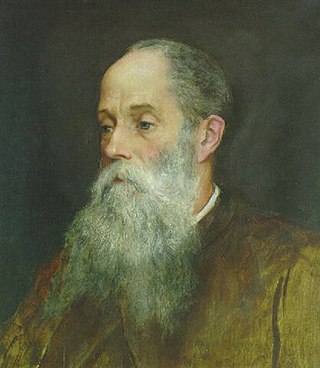
John Roddam Spencer Stanhope was an English artist associated with Edward Burne-Jones and George Frederic Watts and often regarded as a second-wave pre-Raphaelite. His work is also studied within the context of Aestheticism and British Symbolism. As a painter, Stanhope worked in oil, watercolor, fresco, tempera, and mixed media. His subject matter was mythological, allegorical, biblical, and contemporary. Stanhope was born in Cawthorne, near Barnsley, Yorkshire, England, and died in Florence, Italy. He was the uncle and teacher of the painter Evelyn De Morgan and encouraged then unknown local artist Abel Hold to exhibit at the Royal Academy, which he did 16 times.

The Love Potion is a 1903 painting by the English artist Evelyn De Morgan depicting a witch with a black cat familiar at her feet. According to Elise Lawton Smith, the painting "exhibits a Pre-Raphaelite fascination with medieval subjects and decorative detailing." The model was Jane Morris.
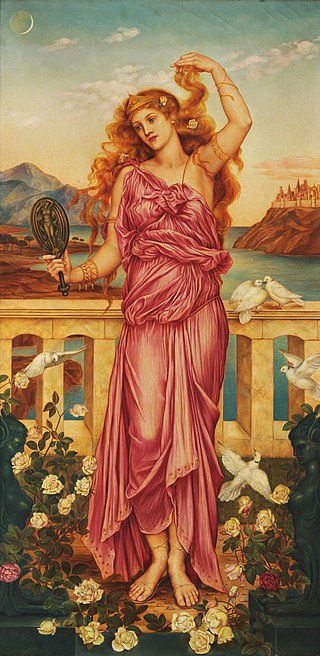
Helen of Troy is an 1898 painting by the English artist Evelyn De Morgan depicting Helen of Troy; it was commissioned by William Imrie of Liverpool.

Anna Marie Diana Wilhelmina Stirling, also known as Wilhelmina Stirling and under the alias Percival Pickering, was a British writer and art collector. A greater part of her books dealt with the lives and reminiscences of the British landed gentry of Yorkshire. She was the founder of the De Morgan Centre for the Study of 19th Century Art and Society.

Adam and Eve is the title of two famous works in different media by Albrecht Dürer, a German artist of the Northern Renaissance: an engraving made in 1504, and a pair of oil-on-panel paintings completed in 1507. The 1504 engraving depicts Adam and Eve in the Garden of Eden, surrounded by several symbolic animals. The engraving transformed how Adam and Eve were popularly depicted in art.

"The Deserted House" is a poem written by Alfred, Lord Tennyson in 1830, as part of his collection Poems, Chiefly Lyrical. The poem is characterised by its reliance on short lines which alternate in rhyme and meter to prevent a felicitous feel. In the poem, Tennyson uses the image of a dark house as a metaphor for a dead body.

Night and Sleep is an 1878 painting by Evelyn De Morgan, an English painter whose works were influenced by the style of the Pre-Raphaelite movement. In the painting dark-haired Night guides her son Sleep. His relaxed pose is set against the "more energetic line of his mother's body." Art historian Elise Lawton Smith notes that the couple's "horizontality suggests both sleep and lateral movement as they pass across the landscape". Poppies, symbolic of sleep, peace, death and the artist's pacifism, are listlessly strewn by the somnolent Sleep as he passes.

The Merciful Knight is a watercolour by the pre-Raphaelite artist Edward Burne-Jones which was completed in 1863 and is currently housed at the Birmingham Museum & Art Gallery.

Thoughts of the Past is an oil painting on canvas by English Pre-Raphaelite artist John Roddam Spencer Stanhope, first exhibited in 1859 and currently housed at Tate Britain.

Gaetano Giuseppe Faostino Meo was an Italian-British artist's model, landscape painter, and a noted craftsman in mosaic and stained glass. His unpublished autobiography is a useful source for art historians of the Aesthetic Movement and Edwardian Era.
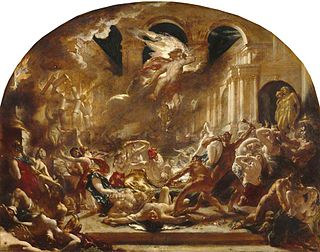
The Destroying Angel and Daemons of Evil Interrupting the Orgies of the Vicious and Intemperate, also known as The Destroying Angel and Daemons Inflicting Divine Vengeance on the Wicked and Intemperate and as The Destruction of the Temple of Vice, is an 1832 English oil painting on canvas by English artist William Etty, first exhibited in 1832. Etty had become famous for nude paintings, and acquired a reputation for tastelessness, indecency and a lack of creativity. With The Destroying Angel he hoped to disprove his critics with an openly moral piece. The painting is 127.8 cm by 101.9 cm and depicts a classical temple under attack from a destroying angel and a group of daemons. Some of the humans appear dead or unconscious, others flee or struggle against the daemons.

Candaules, King of Lydia, Shews his Wife by Stealth to Gyges, One of his Ministers, as She Goes to Bed, rarely known as The Imprudence of Candaules, is a 45.1 by 55.9 cm oil painting on canvas by English artist William Etty, first exhibited at the Royal Academy in 1830. It shows a scene from the Histories by Herodotus, in which Candaules, king of Lydia, invites his bodyguard Gyges to hide in the couple's bedroom and watch his wife Nyssia undress, to prove to him her beauty. Nyssia notices Gyges spying and challenges him to either accept his own execution or to kill Candaules as a punishment. Gyges chooses to kill Candaules and take his place as king. The painting shows the moment at which Nyssia, still unaware that she is being watched by anyone other than her husband, removes the last of her clothes.
The De Morgan Foundation is a charity registered with The Charity Commission For England And Wales, Registered Charity No. 310004 since 1970.
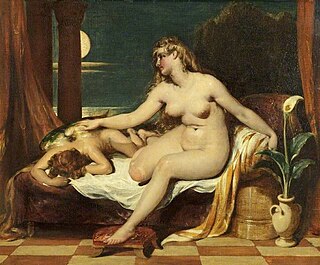
The Dawn of Love, also known as Venus Now Wakes, and Wakens Love, is an oil painting on canvas by English artist William Etty, first exhibited in 1828 and currently in the Russell-Cotes Art Gallery & Museum in Bournemouth. Loosely based on a passage from John Milton's 1634 masque Comus, it shows a nude Venus leaning across to wake the sleeping Love by stroking his wings. While Etty often included nude figures in his work, he rarely depicted physical intimacy, and owing to this, The Dawn of Love is one of his more unusual paintings. The open sensuality of the work was intended to present a challenge to the viewer mirroring the plot of Comus, in which the heroine is tempted by desire but remains rational and detached.


















